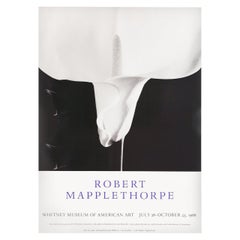Robert Maplethorpe Posters
Recent Sales
Vintage 1980s American Posters
Paper
Robert Mapplethorpe for sale on 1stDibs
Robert Mapplethorpe was born on November 4, 1946, in Floral Park, New York. He left home in 1962 and enrolled at Pratt Institute, Brooklyn, in 1963, where he studied painting and sculpture and received his BFA in 1970. During this time, he met artist, poet, and musician Patti Smith. She encouraged his work and posed for numerous portraits when they lived together in Brooklyn and in the Chelsea Hotel in Manhattan, a gathering place for artists, writers, and musicians in the early 1970s.
It was not Mapplethorpe’s original intention to be a photographer, and from 1970 to 1974, he mainly made assemblage constructions that incorporate images of men from pornographic magazines with found objects and painting. In order to create his own images for these collages, Mapplethorpe turned to photography, initially using a Polaroid SX-70 camera. Interested in portraiture, Mapplethorpe worked as a staff photographer for Andy Warhol’s Interview magazine. He also produced album covers for Smith and the group Television, and at the same time photographed socialites and celebrities such as John Paul Getty III and Carolina Herrera.
Mapplethorpe had his first substantial shows in 1977, both in New York: an exhibition of photographs of flowers at the Holly Solomon Gallery and one of male nudes and sadomasochistic imagery at the Kitchen. Mapplethorpe’s diverse work — homoerotic images, floral still lifes, pictures of children, commissioned portraits, mixed-media sculpture — is united by the constancy of his approach and technique. The surfaces of his prints offer a seemingly endless gradation of blacks and whites, shadow and light, and regardless of subject, his images are both elegant and provocative. In the mid-to-late 1980s, returning to the sculptural use of photography seen in his early assemblages, Mapplethorpe created sensual diptychs and triptychs of photographs printed on fabric and luxurious cloth panels.
In 1988, four major exhibitions of Mapplethorpe’s work were organized: by the Stedelijk Museum, Amsterdam; the Whitney Museum of American Art, New York; the Institute of Contemporary Art, University of Pennsylvania, Philadelphia; and the National Portrait Gallery, London. Mapplethorpe died due to complications from AIDS on March 9, 1989, in Boston.
Find original Robert Mapplethorpe photography on 1stDibs.
(Biography provided by Cerbera Gallery)
Finding the Right posters for You
Add a welcome personal touch to your space and tie your distinctive interior scheme together by introducing antique and vintage posters to any and every room of your home.
In the late 19th century, following the advent of text-heavy posters printed from woodblocks for use in taverns and shop windows, hand-drawn poster art had become commonplace in regions such as France, England and the United States. Well-known illustrators were commissioned to produce decorative posters to advertise political campaigns, theatrical events, books, household goods and other items. Early poster artists used a printmaking technique called lithography, which sees drawings or paintings created on a stone (or metal) surface with an oil-based substance, such as a greasy crayon or tusche (an oily wash). The image is eventually affixed to the surface by means of a chemical reaction, and ink adheres to certain sections of the surface while non–image areas are made to repel the ink.
If you wanted a color lithograph in the early days, the number of stones prepared had to match the number of colors you commissioned for the poster. French painter Jules Chéret, widely known as the father of the modern poster, designed some of history's most popular lithographic posters that featured color. Today, Chéret’s art is highly collectible, along with original works by Czech painter and decorative artist Alphonse Mucha, whose posters advertising theatrical productions helped define Art Nouveau.
Over time, poster artists transitioned to more advanced techniques. Using silkscreens, woodblocks and photolithography, painters and illustrators printed larger quantities at a faster rate.
If you’ve finally tracked down that vintage movie poster, mid-century modern promotional travel poster or other work and you’re looking to find out if it is valuable, distinguishing between an original poster and a reproduction can be complicated. A professional appraiser can work with you on factors such as rarity, assessing the physical condition of your poster and authenticating your piece. For now, take care of your new acquisition because conserving posters is essential in helping them retain their value. A practical conservation method is to have the work mounted on archival, acid-free paper and thin artist’s canvas, then enclosing it in a sturdy frame. (And here is a primer on how to hang wall art, be it arranged gallery-style or otherwise.)
On 1stDibs, find all kinds of posters for your home today.
